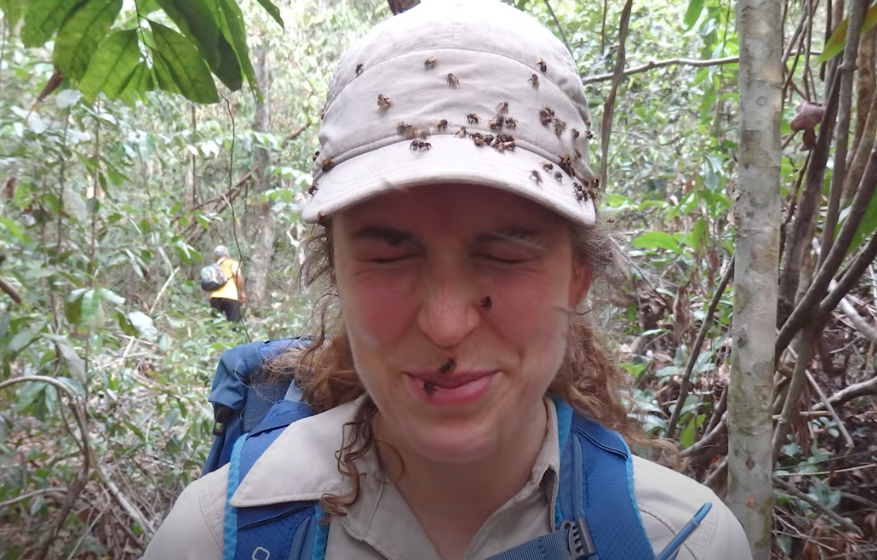From space, parts of the Amazon rainforest that have previously been logged or burned may look fully recovered with a healthy, lush, and green canopy. They may seem to be places buzzing with activity and full of sounds. But inside the rainforest the animal life may tell a different story of damage to their environment through a quieter soundscape.
Scientists from NASA’s Goddard Space Flight Center in Greenbelt, Maryland, and the University of Maryland, College Park, investigated how the acoustics of a forest can be a cost-effective indicator of its health.
Credits: NASA’s Goddard Space Flight Center
Danielle Rappaport, then a doctoral student at the University of Maryland and now co-founder of the Amazon Investor Coalition, led this research beginning in 2016. She and her team combined acoustic data collected under the forest canopy with tree height measurements from aircraft flights and space-based observations of logging or fires from Landsat satellites. Landsat is a long-running partnership between NASA and the U.S. Geological Survey.
In forests that were burned multiple times, recordings of animal noises were quieter than in intact forest locations, leaving gaps in the soundscape and indicating that species that had been present before were now gone. As Rappaport ventured into these previously burned parts of the rainforest to place the recorders for the scientific measurements, she said she could feel the differences.
“I’ve been working with tropical forests all my professional life,” Rappaport said. “I’ve never quite been to a forest that was this devastated. It’s something that you can smell, you can hear, it’s everywhere.”
On the first day of trekking through a forest that had been burned five times throughout the study period, Rappaport’s field assistant temporarily quit due to the oppressive nature of the environment. The environment was harsher in forests that had been burned several times, Rappaport said. The forest undergrowth was thick and difficult to navigate, and insects such as sweat bees surrounded her. However, these on-the-ground differences in the animal environment aren’t observable when forests are measured from space, where the regrown canopy appears almost as green and complete as before the fires.
Instead of choosing specific times of day to target acoustic signatures of well-known species, Rappaport and her team chose to place and leave recorders in degraded forests for extended periods to gather a fuller, species-inclusive repertoire of sound. When analyzed together, these recordings revealed unique ecological fingerprints, or soundscapes. Species of frogs, insects, birds, and primates each occupy sound space in different ways – ways that enable biodiversity and ecological systems to be analyzed without scientists being physically present.
“You can think of the animal soundscape as an orchestra,” Rappaport said. “The flutes occupy a different time of day and a different frequency band than the oboes.”
Her team developed a new way to quantify forest health by analyzing soundscapes with a network theory approach. This means that by using the digital soundscape as a whole – the orchestral music – Rappaport’s team could understand the relationship between the level of impacts and the community of species – the character and quality of the instruments playing – without requiring all the species to be identified.
“It’s one more step towards understanding the sound community without needing to know which individual species are there because we’re starting to listen for them in ways that help us connect the coordinated production of sound, even if we don’t know who’s making the noise,” said Doug Morton, an Earth scientist at NASA Goddard and Rappaport’s PhD advisor.
Knowing where to place the recorders, and how to interpret the diversity of soundscapes, required additional data from lidar measurements taken between 2013 and 2016 and the past 33 years of Landsat satellite records.
“Our ability to analyze decades of history through the Landsat data record provided a strong backbone to this work,” Rappaport said.
The Landsat program, which marked its 50th anniversary in space this July, allowed the scientists to see back in time. The scientists created a timeline of Amazon forest cover for the past three decades, and used the history of forest degradation to determine where to place the recorders. With these data, the team sampled sounds from locations with varying levels of fire and logging activity.
Lidar measurements explain the diversity of soundscapes by providing a three-dimensional representation of the forest’s canopy. Airplanes flew over the forested areas, collecting tree height data that helped determine the layers of the forest between the canopy and the ground.
“That three-dimensional picture still carries a memory of some of those historic disturbances,” Morton said.
These three quantitative datasets layered together helped Rappaport and her team better understand the ecosystem structure of Amazon forests impacted by human activity.
They found that repeatedly burned forests had less biodiversity than forests that were logged once. For example, with each additional forest fire, the soundscape becomes quieter. After logging, the forest soundscape suggested a capacity to recover animal diversity.
Rappaport and her team hope this new technique will open up a new understanding of forest biodiversity that is threatened by fires and logging, and about the relationship between biodiversity and carbon stored in Amazon forests over time. Soundscapes provide a relatively cost-efficient and rapid means of estimating levels of biodiversity in complex and generally species-rich tropical environments.
“Sound data add a new dimension to our understanding of the Amazon,” Morton said. “I’m fascinated by what we still have to learn.”
Download this video in HD formats from NASA Goddard’s Scientific Visualization Studio.
By Erica McNamee
NASA’s Goddard Space Flight Center, Greenbelt, Md.
Media contact: Jake Richmond
NASA’s Goddard Space Flight Center, Greenbelt, Md.



























